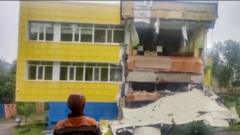The earthquake struck on Wednesday, originating from the Kamchatka Peninsula, and while waves were reported, they did not lead to significant destruction. Communities in the wake of the quake are now assessing immediate recovery efforts.
The seismic event, one of the strongest in recent years, occurred at local time 11:25 on Wednesday. It prompted tsunami alerts that affected areas including parts of Russia, Japan, and Hawaii, resulting in over two million people being advised to evacuate. While there were initial concerns about life-threatening waves due to the earthquake's strength, reports later indicated no severe damage had been sustained.
In Hawaii, residents retreated to higher ground as 1.2-meter waves were recorded in Oahu, and even larger ones at 1.7 meters struck Maui. Governor Josh Green warned of the dangers associated with tsunamis but later informed that the anticipated disaster had not materialized.
Warnings for Hawaii were subsequently downgraded by the Pacific Tsunami Warning Centre (PTWC) to an advisory level, although the Hawaii Emergency Management Agency urged residents to remain cautious while returning home.
Various coastal regions registered minimal surges, with Crescent City, California noting 1.09 meters of wave activity. British Columbia also issued and later lifted an advisory for its coastal areas following reports of minor effects.
In Russia, where the quake originated, some coastal areas faced 5-meter tsunami waves, notably in Severo-Kurilsk, yet reports indicated no significant injuries. The earthquake triggered aftershocks, and even the Klyuchevskoy Volcano began erupting, underscoring the region's seismic volatility.
Japan experienced waves over one meter high, leading to mass evacuations, though no widespread damage was reported. Evacuations occurred around the Fukushima nuclear power plant, although a spokesperson confirmed the facility remained stable.
Alerts from regions as far as French Polynesia and the Philippines were issued and later retracted as wave heights were found to be significantly lower than anticipated. Countries across the Pacific Rim, including Chile and New Zealand, prepared for minor tsunami activity, though ultimately faced no major threats.
This recent seismic activity highlights the dangers inherent in the Pacific Ring of Fire, an area renowned for its seismic activity, where around 80% of the world’s earthquakes occur. Wednesday's earthquake represents one of the strongest recorded, comparable to prior significant quakes in the same region.
The seismic event, one of the strongest in recent years, occurred at local time 11:25 on Wednesday. It prompted tsunami alerts that affected areas including parts of Russia, Japan, and Hawaii, resulting in over two million people being advised to evacuate. While there were initial concerns about life-threatening waves due to the earthquake's strength, reports later indicated no severe damage had been sustained.
In Hawaii, residents retreated to higher ground as 1.2-meter waves were recorded in Oahu, and even larger ones at 1.7 meters struck Maui. Governor Josh Green warned of the dangers associated with tsunamis but later informed that the anticipated disaster had not materialized.
Warnings for Hawaii were subsequently downgraded by the Pacific Tsunami Warning Centre (PTWC) to an advisory level, although the Hawaii Emergency Management Agency urged residents to remain cautious while returning home.
Various coastal regions registered minimal surges, with Crescent City, California noting 1.09 meters of wave activity. British Columbia also issued and later lifted an advisory for its coastal areas following reports of minor effects.
In Russia, where the quake originated, some coastal areas faced 5-meter tsunami waves, notably in Severo-Kurilsk, yet reports indicated no significant injuries. The earthquake triggered aftershocks, and even the Klyuchevskoy Volcano began erupting, underscoring the region's seismic volatility.
Japan experienced waves over one meter high, leading to mass evacuations, though no widespread damage was reported. Evacuations occurred around the Fukushima nuclear power plant, although a spokesperson confirmed the facility remained stable.
Alerts from regions as far as French Polynesia and the Philippines were issued and later retracted as wave heights were found to be significantly lower than anticipated. Countries across the Pacific Rim, including Chile and New Zealand, prepared for minor tsunami activity, though ultimately faced no major threats.
This recent seismic activity highlights the dangers inherent in the Pacific Ring of Fire, an area renowned for its seismic activity, where around 80% of the world’s earthquakes occur. Wednesday's earthquake represents one of the strongest recorded, comparable to prior significant quakes in the same region.



















